Rain-Induced Shallow Landslide Susceptibility Under Multiple Scenarios Based on Effective Antecedent Precipitation
Abstract
1. Introduction
- Based on EAP data from 2064 historical landslides, a high-precision landslide prediction model was developed. Compared to coarse-grained precipitation metrics, the EAP data more accurately capture the mechanism of rainfall-triggered landslides, significantly improving the model’s predictive accuracy. Additionally, the analyses of both the mean decreases in the Gini and SHAP values indicate that EAP is a key factor contributing to landslides.
- Using daily precipitation records from 69 meteorological stations, we evaluate eight probability distribution models to characterize EAP across various return periods, thereby quantifying multiple antecedent rainfall scenarios for hazard analysis.
- We generate dynamic landslide susceptibility maps under different rainfall return periods (5, 10, 20, and 50 years), which identify high-risk zones and illustrate how extreme precipitation probability scenarios impact landslide spatial patterns.
2. Materials and Methods
2.1. Landslide in Zhejiang
2.2. Framework
- Daily precipitation data processing: Data gathered from meteorological stations over multiple years are employed, and various distribution functions are applied for fitting, where the optimal distribution function is chosen to calculate the return period values for each station in the study area. Interpolation is then performed to generate distribution maps of the EAP under different return periods, which are subsequently used for prediction by the following models.
- Additional data processing: First, it is necessary to collect data related to the topography, geology, hydrology, and other relevant factors of the study area, and a landslide inventory is compiled for the region. In this study, 14 conditioning factors from the research area were collected and subjected to multicollinearity analysis to select the appropriate factors.
- Model training: A set of negative samples equal in number to the 2064 landslide points was created, excluding points located within water systems. These negative samples, together with the positive samples, form the training and validation datasets for the model. The random forest (RF), XGBoost, multilayer perceptron (MLP), k-nearest neighbor (KNN), support vector machine (SVM), and gradient boosting machine (GBM) models are trained. A total of 70% of the landslide points are used for training, while the remaining 30% are used for validation.
- Landslide analysis and mapping: In this phase, the importance of each conditioning factor is calculated. In this study, various methods, including SHAP values and the mean decrease in Gini, are employed to compare the different models and assess the importance of the multifactorial variables.
2.3. Data
2.4. Methods
2.4.1. Effective Antecedent Precipitation
2.4.2. Optimal Probability Distribution Model for Effective Antecedent Precipitation
2.4.3. Model Performance Evaluation Methods
3. Results
3.1. Effective Antecedent Precipitation Analysis
3.2. Model Comparison and Validation
3.3. Landslide Results Under Different Return Periods
4. Discussion
4.1. Importance of Effective Antecedent Precipitation in Landslide Disaster Prediction
4.2. Model Interpretation and Technical Limitations
4.3. Uncertainty of Different Precipitation Types on Landslide Disasters
4.4. Landslide Disasters in the Context of Future Climate Change
5. Conclusions
Author Contributions
Funding
Institutional Review Board Statement
Informed Consent Statement
Data Availability Statement
Acknowledgments
Conflicts of Interest
References
- Gómez, D.; García, E.F.; Aristizábal, E. Spatial and temporal landslide distributions using global and open landslide databases. Nat. Hazards 2023, 117, 25–55. [Google Scholar] [CrossRef]
- Casagli, N.; Intrieri, E.; Tofani, V.; Gigli, G.; Raspini, F. Landslide detection, monitoring and prediction with remote-sensing techniques. Nat. Rev. Earth Environ. 2023, 4, 51–64. [Google Scholar] [CrossRef]
- Li, Z.; Shi, A.; Li, X.; Dou, J.; Li, S.; Chen, T.; Chen, T. Deep learning-based landslide recognition incorporating deformation characteristics. Remote Sens. 2024, 16, 992. [Google Scholar] [CrossRef]
- Jiang, Y.; Hu, X.; Liang, H.; Ning, P.; Fan, X. A physically based model for the sequential evolution analysis of rainfall-induced shallow landslides in a catchment. Water Resour. Res. 2023, 59, e2022WR032716. [Google Scholar] [CrossRef]
- Hu, X.; Jiang, Y.; Ning, P.; Liang, H.; Fan, X.; Liu, W.; Zhu, Y. A hydrodynamic-based physical unified modeling for simulating shallow landslide local failures, mass release and debris flow run-out extent behavior. Water Resour. Res. 2024, 60, e2023WR036289. [Google Scholar] [CrossRef]
- Cui, Y.; Jiang, Y.; Guo, C. Investigation of the initiation of shallow failure in widely graded loose soil slopes considering interstitial flow and surface runoff. Landslides 2019, 16, 815–828. [Google Scholar] [CrossRef]
- Iverson, R.M. Landslide triggering by rain infiltration. Water Resour. Res. 2000, 36, 1897–1910. [Google Scholar] [CrossRef]
- Shrestha, H.K.; Yatabe, R.; Bhandary, N.P. Groundwater flow modeling for effective implementation of landslide stability enhancement measures. Landslides 2008, 5, 281–290. [Google Scholar] [CrossRef]
- Conte, E.; Pugliese, L.; Troncone, A. A simple method for predicting rainfall-induced shallow landslides. J. Geotech. Geoenvironmental Eng. 2022, 148, 04022079. [Google Scholar] [CrossRef]
- Suárez, G.; Domínguez-Cuesta, M.J. Physical Vulnerability and Landslide Risk Assessment in Tegucigalpa City, Honduras. Appl. Sci. 2024, 14, 9114. [Google Scholar] [CrossRef]
- Montoya-Araque, E.A.; Montoya-Noguera, S. Sensitivity analysis of a physically based model to assess rainfall-triggered shallow landslides. Geotech. Geol. Eng. 2023, 41, 2797–2814. [Google Scholar] [CrossRef]
- Zou, Z.; Yan, J.; Tang, H.; Wang, S.; Xiong, C.; Hu, X. A shear constitutive model for describing the full process of the deformation and failure of slip zone soil. Eng. Geol. 2020, 276, 105766. [Google Scholar] [CrossRef]
- Pajalić, S.; Peranić, J.; Maksimović, S.; Čeh, N.; Jagodnik, V.; Arbanas, Ž. Monitoring and data analysis in small-scale landslide physical model. Appl. Sci. 2021, 11, 5040. [Google Scholar] [CrossRef]
- Yao, Z.; Chen, M.; Zhan, J.; Zhuang, J.; Sun, Y.; Yu, Q.; Yu, Z. Refined Landslide Susceptibility Mapping by Integrating the SHAP-CatBoost Model and InSAR Observations: A Case Study of Lishui, Southern China. Appl. Sci. 2023, 13, 12817. [Google Scholar] [CrossRef]
- Villaça, C.; Santos, P.P.; Zêzere, J.L. Modelling the rainfall threshold for shallow landslides considering the landslide pre-disposing factors in Portugal. Landslides 2024, 21, 2119–2133. [Google Scholar] [CrossRef]
- Okoli, J.; Nahazanan, H.; Nahas, F.; Kalantar, B.; Mohd Shafri, H.Z.; Khuzaimah, Z. High-resolution lidar-derived DEM for landslide susceptibility assessment using AHP and fuzzy logic in Serdang, Malaysia. Geosciences 2023, 13, 34. [Google Scholar] [CrossRef]
- Podolszki, L.; Karlović, I. Remote sensing and GIS in landslide management: An example from the Kravarsko Area, Croatia. Remote Sens. 2023, 15, 5519. [Google Scholar] [CrossRef]
- Zhang, J.; Yin, K.; Wang, J.; Liu, L.; Huang, F. Evaluation of landslide susceptibility for Wanzhou district of Three Gorges Reservoir. Chin. J. Rock Mech. Eng. 2016, 35, 284–296. [Google Scholar] [CrossRef]
- Zhang, P.; Xu, C.; Ma, S.; Shao, X.; Tian, Y.; Wen, B. Automatic extraction of seismic landslides in large areas with complex environments based on deep learning: An example of the 2018 iburi earthquake, Japan. Remote Sens. 2020, 12, 3992. [Google Scholar] [CrossRef]
- Ado, M.; Amitab, K.; Maji, A.K.; Jasińska, E.; Gono, R.; Leonowicz, Z.; Jasiński, M. Landslide susceptibility mapping using machine learning: A literature survey. Remote Sens. 2022, 14, 3029. [Google Scholar] [CrossRef]
- Guo, Z.; Guo, F.; Zhang, Y.; He, J.; Li, G.; Yang, Y.; Zhang, X. A python system for regional landslide susceptibility assessment by integrating machine learning models and its application. Heliyon 2023, 9, e21542. [Google Scholar] [CrossRef] [PubMed]
- Caine, N. The rainfall intensity-duration control of shallow landslides and debris flows. Geogr. Ann. Ser. A Phys. Geogr. 1980, 62, 23–27. [Google Scholar] [CrossRef]
- Ning, S.; Ge, Y.; Bai, S.; Ma, C.; Sun, Y. I–D Threshold Analysis of Rainfall-Triggered Landslides Based on TRMM Precipitation Data in Wudu, China. Remote Sens. 2023, 15, 3892. [Google Scholar] [CrossRef]
- Saha, S.; Bera, B. Rainfall threshold for prediction of shallow landslides in the Garhwal Himalaya, India. Geosyst. Geoenviron. 2024, 3, 100285. [Google Scholar] [CrossRef]
- Rosi, A.; Canavesi, V.; Segoni, S.; Dias Nery, T.; Catani, F.; Casagli, N. Landslides in the mountain region of Rio de Janeiro: A proposal for the semi-automated definition of multiple rainfall thresholds. Geosciences 2019, 9, 203. [Google Scholar] [CrossRef]
- Abella, E.A.C.; Van Westen, C.J. Qualitative landslide susceptibility assessment by multicriteria analysis: A case study from San Antonio del Sur, Guantánamo, Cuba. Geomorphology 2008, 94, 453–466. [Google Scholar] [CrossRef]
- Panchal, S.; Shrivastava, A.K. Landslide hazard assessment using analytic hierarchy process (AHP): A case study of National Highway 5 in India. Ain Shams Eng. J. 2022, 13, 101626. [Google Scholar] [CrossRef]
- Sabokbar, H.F.; Roodposhti, M.S.; Tazik, E. Landslide susceptibility mapping using geographically-weighted principal component analysis. Geomorphology 2014, 226, 15–24. [Google Scholar] [CrossRef]
- Ayalew, L.; Yamagishi, H. The application of GIS-based logistic regression for landslide susceptibility mapping in the Kakuda-Yahiko Mountains, Central Japan. Geomorphology 2005, 65, 15–31. [Google Scholar] [CrossRef]
- Wang, L.J.; Sawada, K.; Moriguchi, S. Landslide susceptibility analysis with logistic regression model based on FCM sampling strategy. Comput. Geosci. 2013, 57, 81–92. [Google Scholar] [CrossRef]
- Wei, Y.; Qiu, H.; Liu, Z.; Huangfu, W.; Zhu, Y.; Liu, Y.; Kamp, U. Refined and dynamic susceptibility assessment of landslides using InSAR and machine learning models. Geosci. Front. 2024, 15, 101890. [Google Scholar] [CrossRef]
- Shirzadi, A.; Solaimani, K.; Roshan, M.H.; Kavian, A.; Chapi, K.; Shahabi, H.; Bui, D.T. Uncertainties of prediction accuracy in shallow landslide modeling: Sample size and raster resolution. Catena 2019, 178, 172–188. [Google Scholar] [CrossRef]
- Xu, C.; Dai, F.; Xu, X.; Lee, Y.H. GIS-based support vector machine modeling of earthquake-triggered landslide susceptibility in the Jianjiang River watershed, China. Geomorphology 2012, 145, 70–80. [Google Scholar] [CrossRef]
- Sun, D.; Xu, J.; Wen, H.; Wang, D. Assessment of landslide susceptibility mapping based on Bayesian hyperparameter optimization: A comparison between logistic regression and random forest. Eng. Geol. 2021, 281, 105972. [Google Scholar] [CrossRef]
- Huang, C.; Li, F.; Wei, L.; Hu, X.; Yang, Y. Landslide susceptibility modeling using a deep random neural network. Appl. Sci. 2022, 12, 12887. [Google Scholar] [CrossRef]
- Han, L.; Zhang, J.; Zhang, Y.; Ma, Q.; Alu, S.; Lang, Q. Hazard assessment of earthquake disaster chains based on a Bayesian network model and ArcGIS. ISPRS Int. J. Geo-Inf. 2019, 8, 210. [Google Scholar] [CrossRef]
- Chang, Z.; Du, Z.; Zhang, F.; Huang, F.; Chen, J.; Li, W.; Guo, Z. Landslide susceptibility prediction based on remote sensing images and GIS: Comparisons of supervised and unsupervised machine learning models. Remote Sens. 2020, 12, 502. [Google Scholar] [CrossRef]
- Ali, N.; Chen, J.; Fu, X.; Ali, R.; Hussain, M.A.; Daud, H.; Altalbe, A. Integrating machine learning ensembles for landslide susceptibility mapping in Northern Pakistan. Remote Sens. 2024, 16, 988. [Google Scholar] [CrossRef]
- Dias, H.C.; Hölbling, D.; Grohmann, C.H. Examining the influence of different inventories on shallow landslide suscep--tibility modeling: An assessment using machine learning and statistical approaches. Geosciences 2025, 15, 77. [Google Scholar] [CrossRef]
- Khaliq, A.H.; Basharat, M.; Riaz, M.T.; Wani, S.; Al-Ansari, N.; Linh, N.T.T. Spatiotemporal landslide susceptibility mapping using machine learning models: A case study from district Hattian Bala, NW Himalaya, Pakistan. Ain Shams Eng. J. 2023, 14, 101907. [Google Scholar] [CrossRef]
- Liu, Y.; Deng, Z.; Wang, X. The effects of rainfall, soil type and slope on the processes and mechanisms of rainfall-induced shallow landslides. Appl. Sci. 2021, 11, 11652. [Google Scholar] [CrossRef]
- Lin, Q.; Steger, S.; Pittore, M.; Zhang, J.; Wang, L.; Jiang, T.; Wang, Y. Evaluation of potential changes in landslide susceptibility and landslide occurrence frequency in China under climate change. Sci. Total Environ. 2022, 850, 158049. [Google Scholar] [CrossRef] [PubMed]
- Kang, J.; Wan, B.; Gao, Z.; Zhou, S.; Chen, H.; Shen, H. Research on machine learning forecasting and early warning model for rainfall-induced landslides in Yunnan province. Sci. Rep. 2024, 14, 14049. [Google Scholar] [CrossRef]
- Nanda, A.M.; Lone, F.A.; Ahmed, P. Prediction of rainfall-induced landslide using machine learning models along highway Bandipora to Gurez road, India. Nat. Hazards 2024, 120, 6169–6197. [Google Scholar] [CrossRef]
- Huang, F.; Teng, Z.; Yao, C.; Jiang, S.H.; Catani, F.; Chen, W.; Huang, J. Uncertainties of landslide susceptibility prediction: Influences of random errors in landslide conditioning factors and errors reduction by low pass filter method. J. Rock Mech. Geotech. Eng. 2024, 16, 213–230. [Google Scholar] [CrossRef]
- Reichenbach, P.; Rossi, M.; Malamud, B.D.; Mihir, M.; Guzzetti, F. A review of statistically-based landslide susceptibility models. Earth-Sci. Rev. 2018, 180, 60–91. [Google Scholar] [CrossRef]
- Sun, L.; Ma, B.; Pei, L.; Zhang, X.; Zhou, J.L. The relationship of human activities and rainfall-induced landslide and debris flow hazards in Central China. Nat. Hazards 2021, 107, 147–169. [Google Scholar] [CrossRef]
- Hartmann, J.; Moosdorf, N. The new global lithological map database GLiM: A representation of rock properties at the Earth surface. Geochem. Geophys. Geosyst. 2012, 13, 12. [Google Scholar] [CrossRef]
- Moore, I.D.; Wilson, J.P. Length-slope factors for the Revised Universal Soil Loss Equation: Simplified method of estimation. J. Soil Water Conserv. 1992, 47, 423–428. [Google Scholar] [CrossRef]
- Li, G.; Liu, P.; Zhang, K.; Wu, Q.; Li, Y. Analysis of the influence of dimensional unity in landslide susceptibility assessment. Hydrogeol. Eng. Geol. 2024, 51, 118–129. [Google Scholar] [CrossRef]
- Crozier, M.J. Landslides: Causes, Consequences, and Environment; Croom Helm: London, UK, 1986; p. 252. [Google Scholar]
- Kohler, M.A.; Linsley, R.K. Predicting the Runoff from Storm Rainfall (US Weather Bureau Research Paper No. 34); U.S. Government Printing Office: Washington, DC, USA, 1951.
- Crozier, M.J.; Eyles, R.J. Assessing the Probability of Rapid Mass Movement. In Proceedings of the Australia-New Zealand Conference on Geomechanics, Wellington, New Zealand; 1980; pp. 2–47. [Google Scholar]
- Bruce, J.P.; Clark, R.H. Introduction to Hydrometeorology; Pergamon Press: New York, NY, USA, 1966. [Google Scholar]
- Tohari, A. Study of rainfall-induced landslide: A review. IOP Conf. Ser. Earth Environ. Sci. 2018, 118, 012036. [Google Scholar] [CrossRef]
- Chen, H.X.; Zhang, L.M. A physically-based distributed cell model for predicting regional rainfall-induced shallow slope failures. Eng. Geol. 2014, 176, 79–92. [Google Scholar] [CrossRef]
- Akaike, H. Information theory and an extension of the maximum likelihood principle. In Selected Papers of Hirotugu Akaike; Springer: New York, NY, USA, 1998; pp. 199–213. [Google Scholar]
- Berger, V.W.; Zhou, Y. Kolmogorov–Smirnov test: Overview. In Wiley StatsRef: Stat. Ref. Online; John Wiley & Sons, Ltd.: New York, NY, USA, 2014. [Google Scholar]
- Hutchinson, M.F. Interpolating Mean Rainfall Using Thin Plate Smoothing Splines. Int. J. Geogr. Inf. Sci. 1995, 9, 385–403. [Google Scholar] [CrossRef]
- Jakeman, A.J.; Littlewood, I.G.; Whitehead, P.G. An assessment of the dynamic response characteristics of streamflow in the Balquhidder catchments. J. Hydrol. 1993, 145, 337–355. [Google Scholar] [CrossRef]
- Hengl, T.; Heuvelink, G.B.; Rossiter, D.G. About regression-kriging: From equations to case studies. Comput. Geosci. 2007, 33, 1301–1315. [Google Scholar] [CrossRef]
- Breiman, L. Random forests. Mach. Learn. 2001, 45, 5–32. [Google Scholar] [CrossRef]
- Vapnik, V. The Nature of Statistical Learning Theory; Springer Science & Business Media: Berlin/Heidelberg, Germany, 2013. [Google Scholar]
- Sharma, N.; Saharia, M.; Ramana, G.V. High resolution landslide susceptibility mapping using ensemble machine learning and geospatial big data. Catena 2024, 235, 107653. [Google Scholar] [CrossRef]
- Zhang, G.; Wang, S.; Chen, Z.; Liu, Y.; Xu, Z.; Zhao, R. Landslide susceptibility evaluation integrating weight of evidence model and InSAR results, west of Hubei Province, China. Egypt. J. Remote Sens. Space Sci. 2023, 26, 95–106. [Google Scholar] [CrossRef]
- Friedman, J.H. Greedy Function Approximation: A Gradient Boosting Machine. Ann. Stat. 2001, 29, 1189–1232. [Google Scholar] [CrossRef]
- Cover, T.; Hart, P. Nearest neighbor pattern classification. IEEE Trans. Inf. Theory 1967, 13, 21–27. [Google Scholar] [CrossRef]
- Han, H.; Guo, X.; Yu, H. Variable selection using mean decrease accuracy and mean decrease gini based on random forest. In Proceedings of the 2016 7th IEEE International Conference on Software Engineering and Service Science (ICSESS), Beijing, China, 26–28 August 2016; IEEE: New York, NY, USA, 2016; pp. 219–224. [Google Scholar] [CrossRef]
- Li, C.; Ma, T.; Zhu, X.; Li, W. The power–law relationship between landslide occurrence and rainfall level. Geomorphology 2011, 130, 221–229. [Google Scholar] [CrossRef]
- Campbell, R.H. Soil Slips, Debris Flows, and Rainstorms in the Santa Monica Mountains and Vicinity, Southern California; U.S. Geological Survey: Washington, DC, USA, 1975; Volume 851.
- Shao, X.; Ma, S.; Xu, C.; Xu, Y. Insight into the characteristics and triggers of loess landslides during the 2013 heavy rainfall event in the Tianshui area, China. Remote Sens. 2023, 15, 4304. [Google Scholar] [CrossRef]
- Tang, Z.; Zheng, X.; Pan, J.; Huang, X.; Zhu, L.; Wang, N.; Song, C. Spatial joint hazard assessment of landslide susceptibility and intensity within a single framework: Environmental insights from the Wenchuan earthquake. Sci. Total Environ. 2025, 963, 178545. [Google Scholar] [CrossRef]
- Yang, C.; Liu, L.L.; Huang, F.; Huang, L.; Wang, X.M. Machine learning-based landslide susceptibility assessment with optimized ratio of landslide to non-landslide samples. Gondwana Res. 2023, 123, 198–216. [Google Scholar] [CrossRef]
- Lan, H.; Zhou, C.; Wang, L.; Zhang, H.; Li, R. Landslide hazard spatial analysis and prediction using GIS in the Xiaojiang watershed, Yunnan, China. Eng. Geol. 2004, 76, 109–128. [Google Scholar] [CrossRef]
- He, K.; Chen, X.; Zhao, D.; Yu, X.; Jin, Y.; Liang, Y. Precipitation-induced landslide risk escalation in China’s urbanization with high-resolution soil moisture and multi-source precipitation product. J. Hydrol. 2024, 638, 131536. [Google Scholar] [CrossRef]
- Abraham, M.T.; Satyam, N.; Rosi, A.; Pradhan, B.; Segoni, S. Usage of antecedent soil moisture for improving the performance of rainfall thresholds for landslide early warning. Catena 2021, 200, 105147. [Google Scholar] [CrossRef]
- Bogaard, T.A.; Greco, R. Landslide hydrology: From hydrology to pore pressure. Wiley Interdiscip. Rev. Water 2016, 3, 439–459. [Google Scholar] [CrossRef]
- Van Asch, T.W.J.; Buma, J.; Van Beek, L.P.H. A view on some hydrological triggering systems in landslides. Geomorphology 1999, 30, 25–32. [Google Scholar] [CrossRef]
- Glade, T.; Crozier, M.J.; Smith, P. Applying probability determination to refine landslide-triggering rainfall thresholds using an empirical “antecedent daily rainfall model”. Pure Appl. Geophys. 2000, 157, 1059–1079. [Google Scholar] [CrossRef]
- Hong, Y.; Adler, R.F.; Huffman, G.J. Use of satellite remote sensing data in the prediction of hydrological parameters for landslide hazard assessment. Geol. Soc. Am. Rev. Eng. Geol. 2005, 16, 129–140. [Google Scholar] [CrossRef]
- Zhao, Y.; Wu, X.; Zhang, W.; Lan, P.; Qin, G.; Li, X.; Li, H. A deep learning-based probabilistic approach to flash flood warnings in mountainous catchments. J. Hydrol. 2025, 652, 132677. [Google Scholar] [CrossRef]
- Ma, T.; Li, C.; Lu, Z.; Wang, B. An effective antecedent precipitation model derived from the power-law relationship between landslide occurrence and rainfall level. Geomorphology 2014, 216, 187–192. [Google Scholar] [CrossRef]
- Gariano, S.L.; Guzzetti, F. Landslides in a changing climate. Earth Sci. Rev. 2016, 162, 227–252. [Google Scholar] [CrossRef]
- Zhou, Y.; Wu, X.; Zhang, L.; Liu, J.; Zhan, W.; Lin, Y.; Lin, P. Spatial prediction of rainfall-induced landslides in a tropical mountainous area: A comparison of three hybrid machine learning models. Geosci. Front. 2021, 12, 101–116. [Google Scholar] [CrossRef]
- Kulsoom, I.; Hua, W.; Hussain, S.; Chen, Q.; Khan, G.; Shihao, D. SBAS-InSAR based validated landslide susceptibility mapping along the Karakoram Highway: A case study of Gilgit-Baltistan, Pakistan. Sci. Rep. 2023, 13, 3344. [Google Scholar] [CrossRef]
- Abbas, F.; Zhang, F.; Hussain, M.A.; Abbas, H.; Alrefaei, A.F.; Albeshr, M.F.; Iqbal, J.; Ghani, J. Landslide susceptibility assessment along the Karakoram highway, Gilgit Baltistan, Pakistan: A comparative study between ensemble and neighbor-based machine learning algorithms. Sci. Remote Sens. 2024, 9, 100132. [Google Scholar] [CrossRef]
- Beyer, K.; Goldstein, J.; Ramakrishnan, R.; Shaft, U. When is “nearest neighbor” meaningful? In Proceedings of the Database Theory—ICDT’99: 7th International Conference, Jerusalem, Israel, 10–12 January 1999; Springer: Berlin/Heidelberg, Germany, 1999; pp. 217–235. [Google Scholar] [CrossRef]
- LeCun, Y.; Bengio, Y.; Hinton, G. Deep learning. Nature 2015, 521, 436–444. [Google Scholar] [CrossRef]
- Zhang, A.; Lipton, Z.; Li, M.; Smola, A. Dive into Deep Learning; Springer: Berlin/Heidelberg, Germany, 2021. [Google Scholar]
- Xu, F.; Yuan, H.; Lin, L.; Chen, W. Convective-scale ensemble forecasts of the heavy precipitation of Typhoon Lekima (2019) in Zhejiang Province. Atmos. Res. 2023, 283, 106543. [Google Scholar] [CrossRef]
- Chen, G.; Du, Y.; Wen, Z. Seasonal, interannual, and interdecadal variations of the East Asian summer monsoon: A diurnal-cycle perspective. J. Clim. 2021, 34, 4403–4421. [Google Scholar] [CrossRef]
- Jones, N.; Manconi, A.; Strom, A. Active landslides in the Rogun Catchment, Tajikistan, and their river damming hazard potential. Landslides 2021, 18, 3599–3613. [Google Scholar] [CrossRef]
- Hao, J.; Wu, T.; Wu, X.; Hu, G.; Zou, D.; Zhu, X.; Ma, W. Investigation of a small landslide in the Qinghai-Tibet Plateau by InSAR and absolute deformation model. Remote Sens. 2019, 11, 2126. [Google Scholar] [CrossRef]
- Zhang, M.; Chen, Y.; Shen, Y.; Li, Y. Changes of precipitation extremes in arid Central Asia. Quatern. Int. 2017, 436, 16–27. [Google Scholar] [CrossRef]
- Dong, G.; Jiang, Z.; Tian, Z.; Buonomo, E.; Sun, L.; Fan, D. Projecting changes in mean and extreme precipitation over eastern China during 2041–2060. Earth Space Sci. 2020, 7, e2019EA001024. [Google Scholar] [CrossRef]
- Qin, P.; Xie, Z. Detecting changes in future precipitation extremes over eight river basins in China using RegCM4 downscaling. J. Geophys. Res. Atmos. 2016, 121, 6802–6821. [Google Scholar] [CrossRef]
- Ge, S.; Wang, J.; Jiang, C. Projection of the precipitation-induced landslide risk in China by 2050. Environ. Res. Lett. 2024, 19, 024048. [Google Scholar] [CrossRef]
- Liu, J.; Wu, Y.; Gao, X. Increase in occurrence of large glacier-related landslides in the high mountains of Asia. Sci. Rep. 2021, 11, 1635. [Google Scholar] [CrossRef]

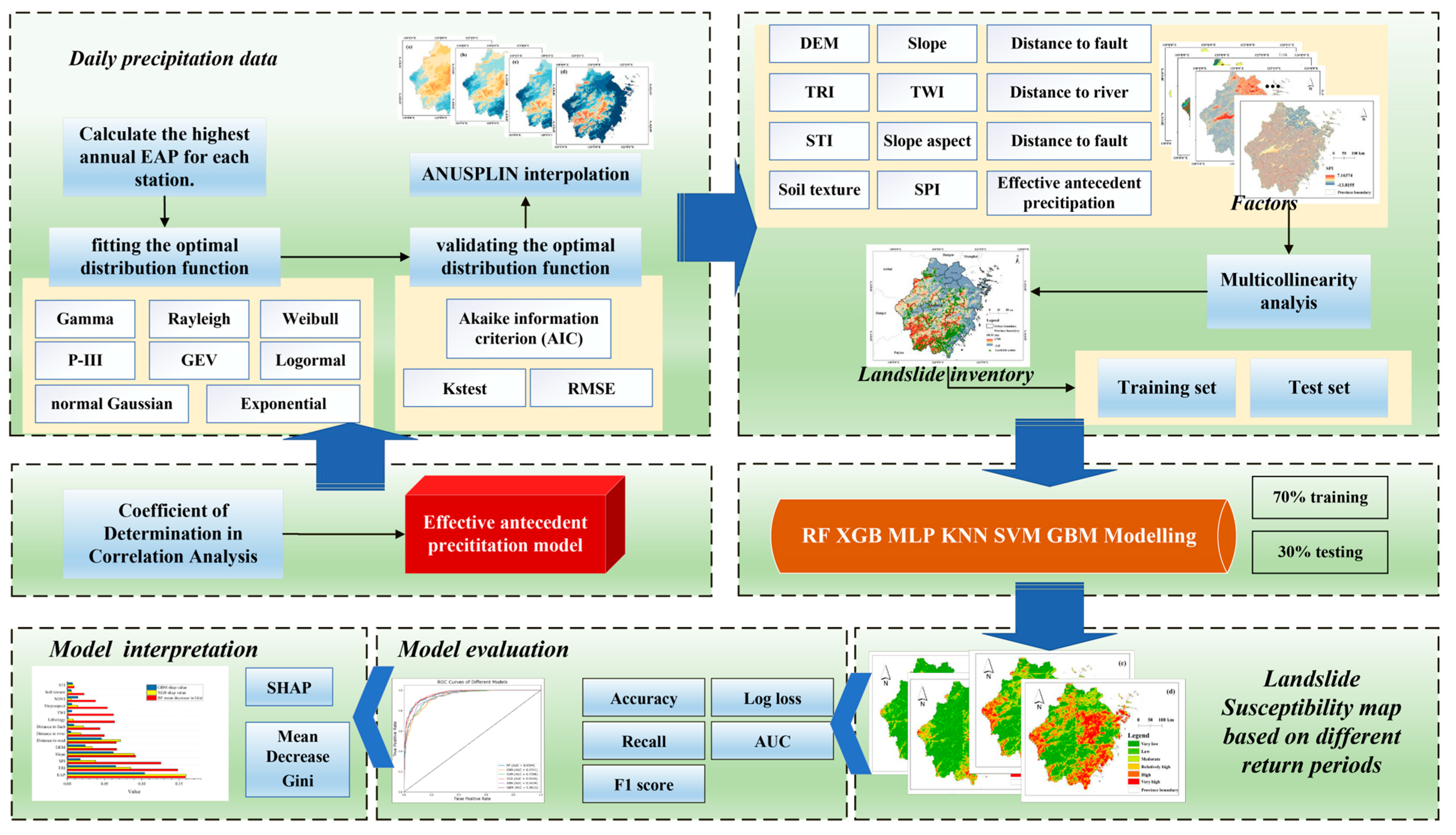
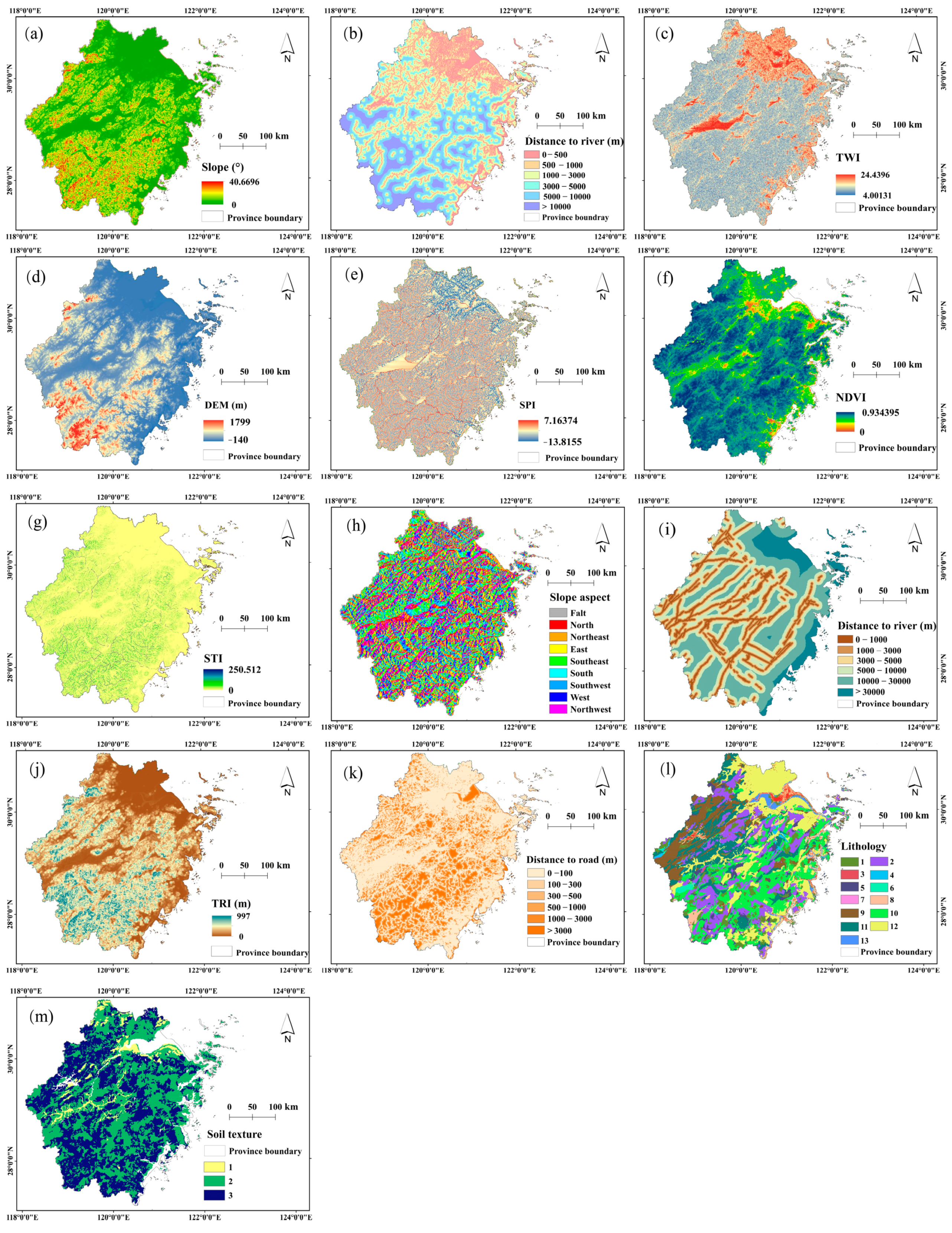

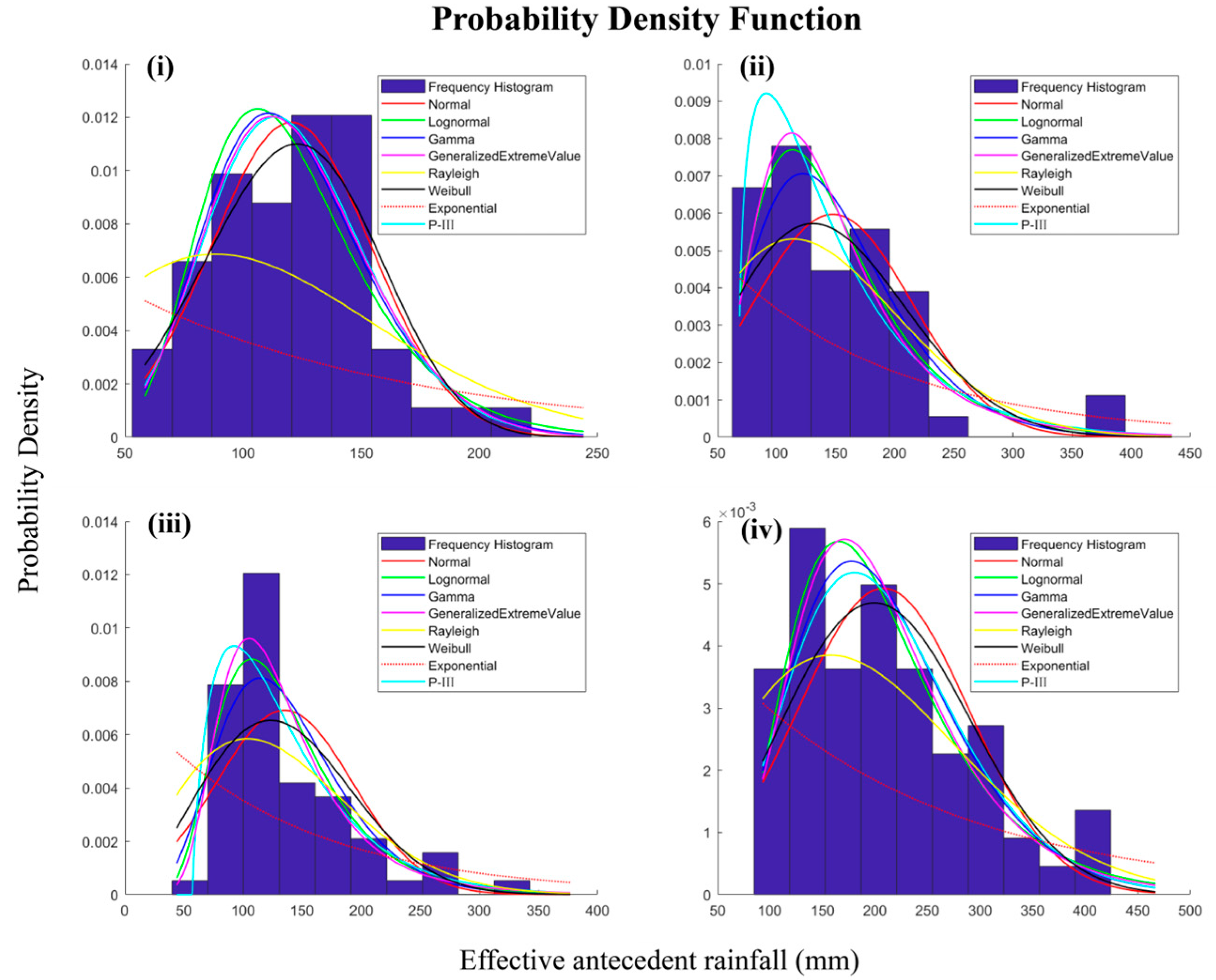
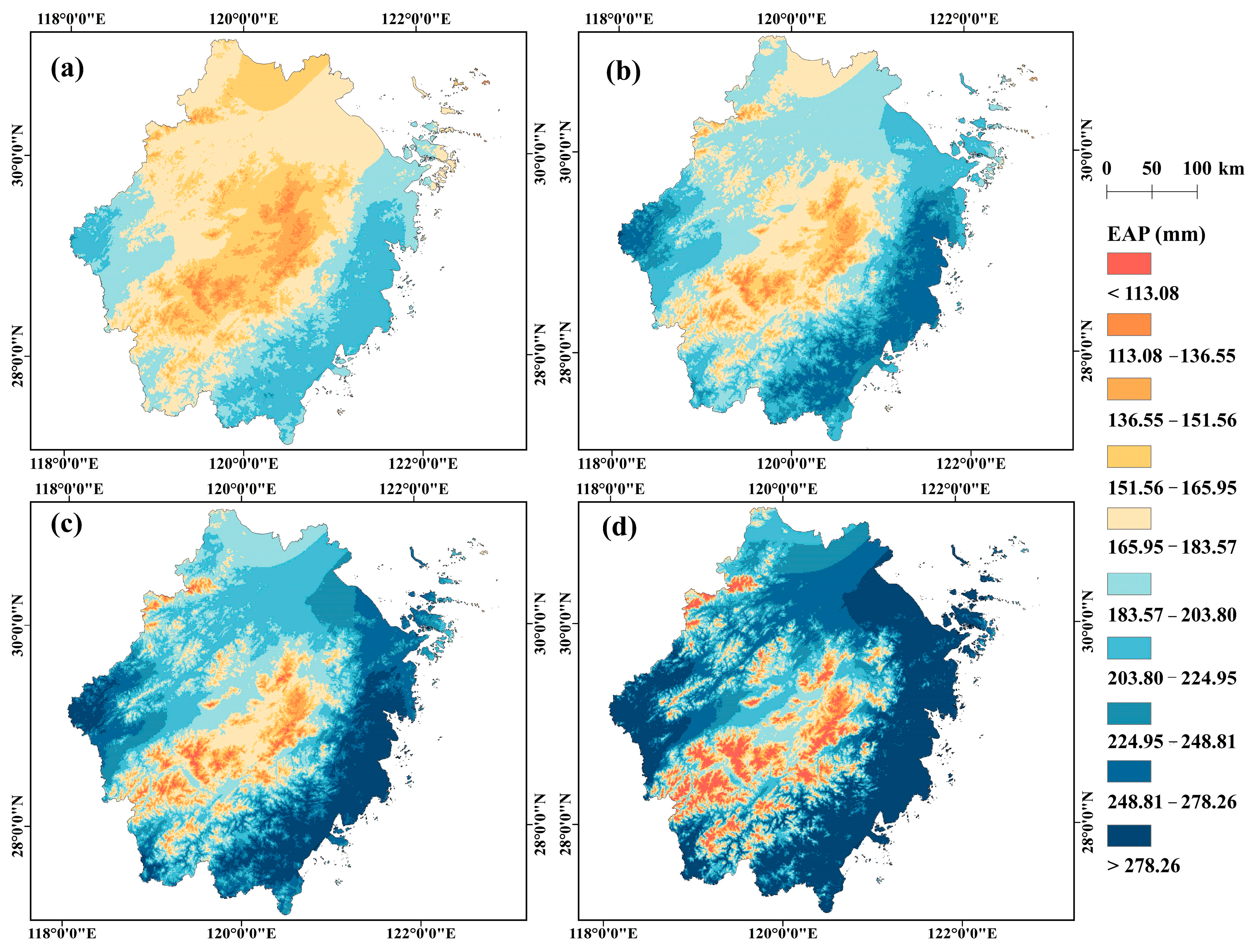
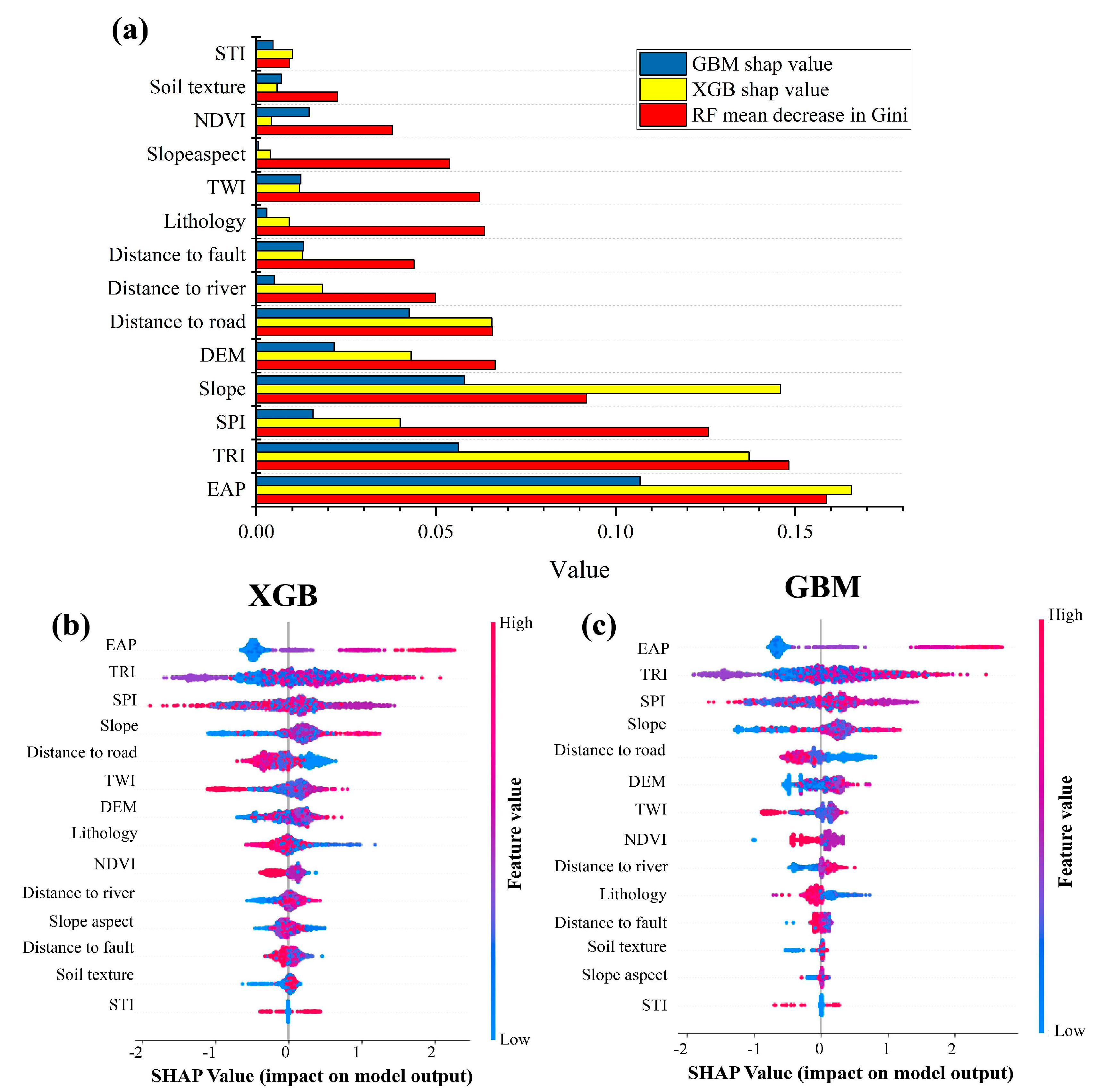
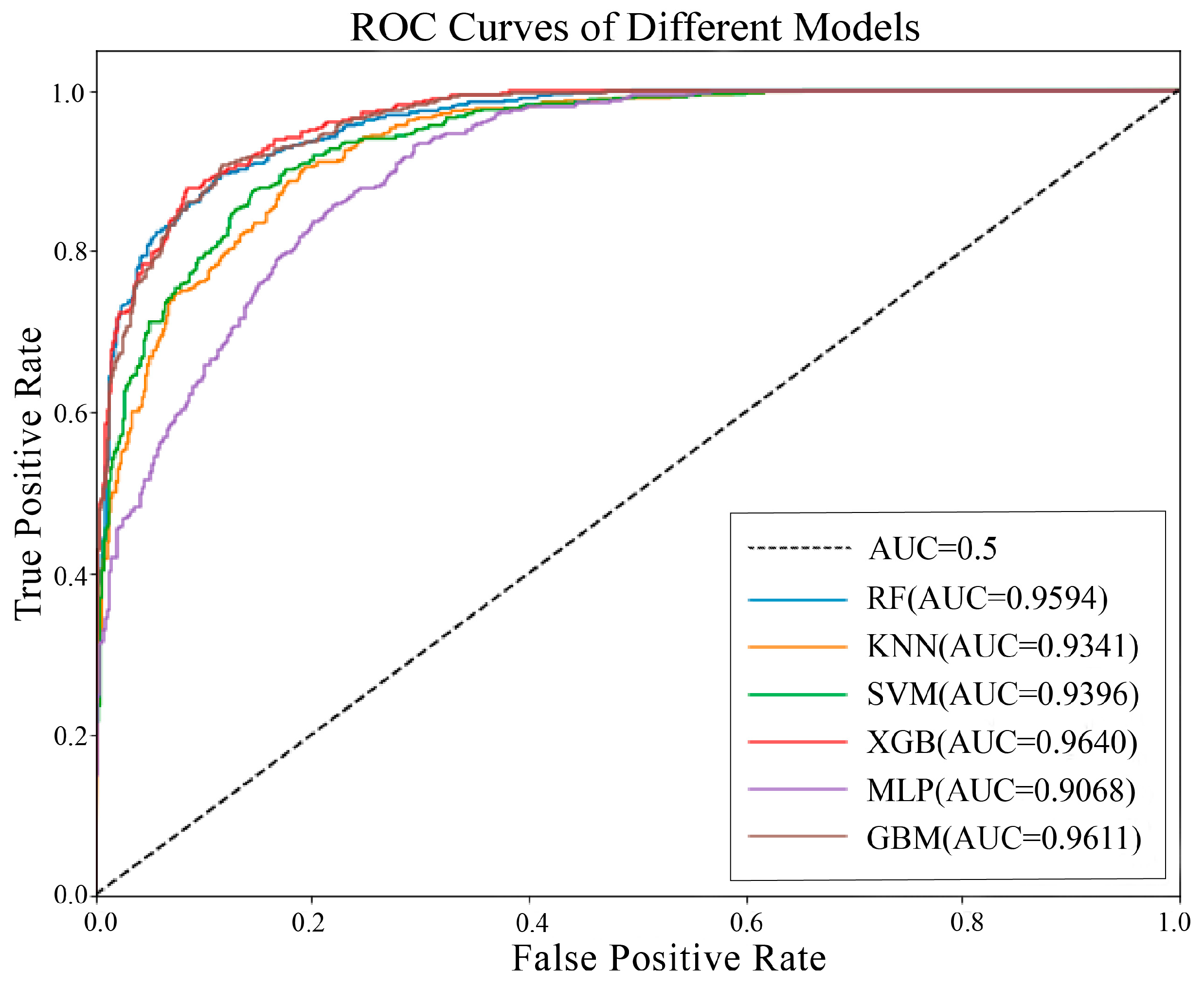
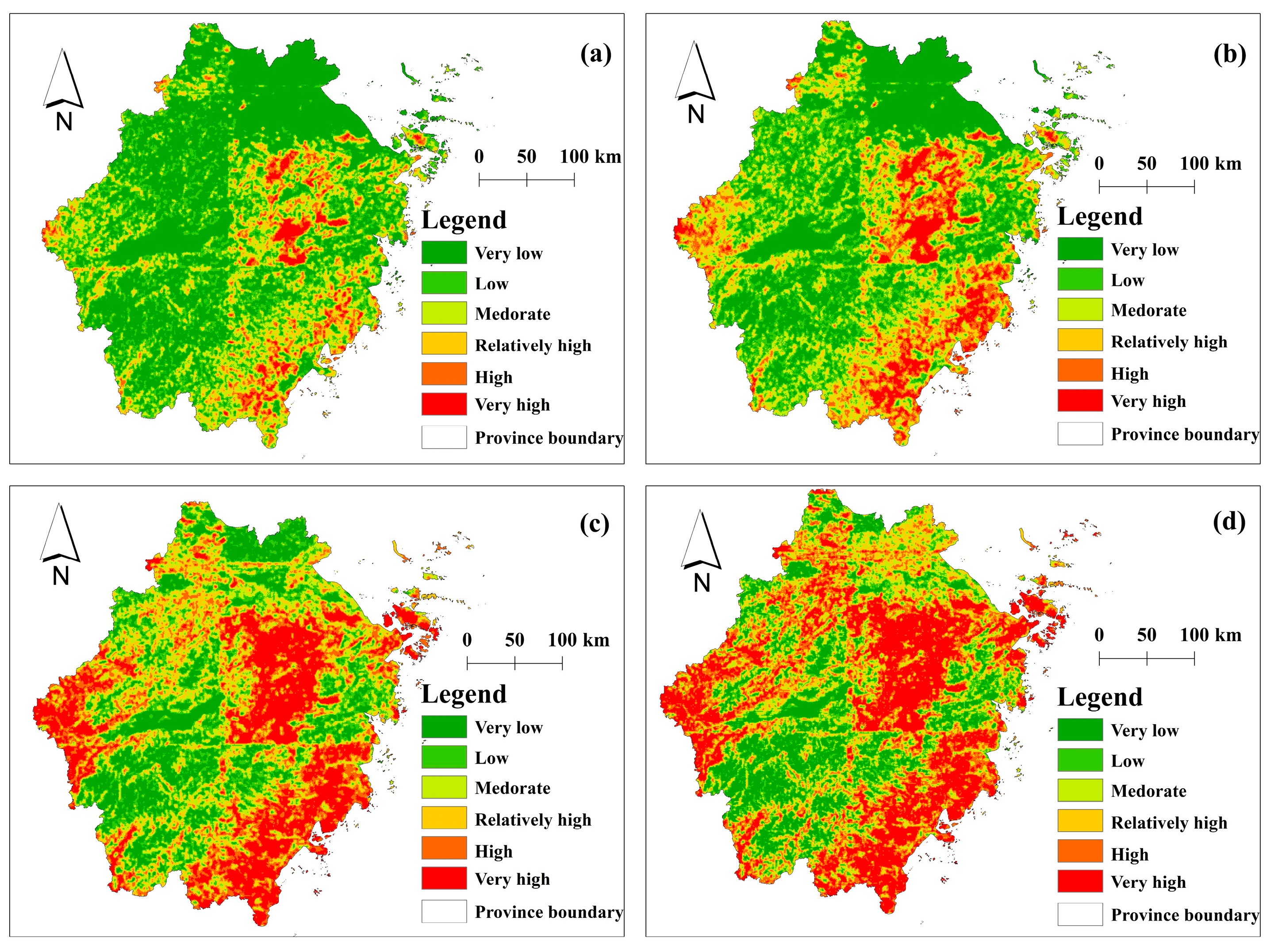
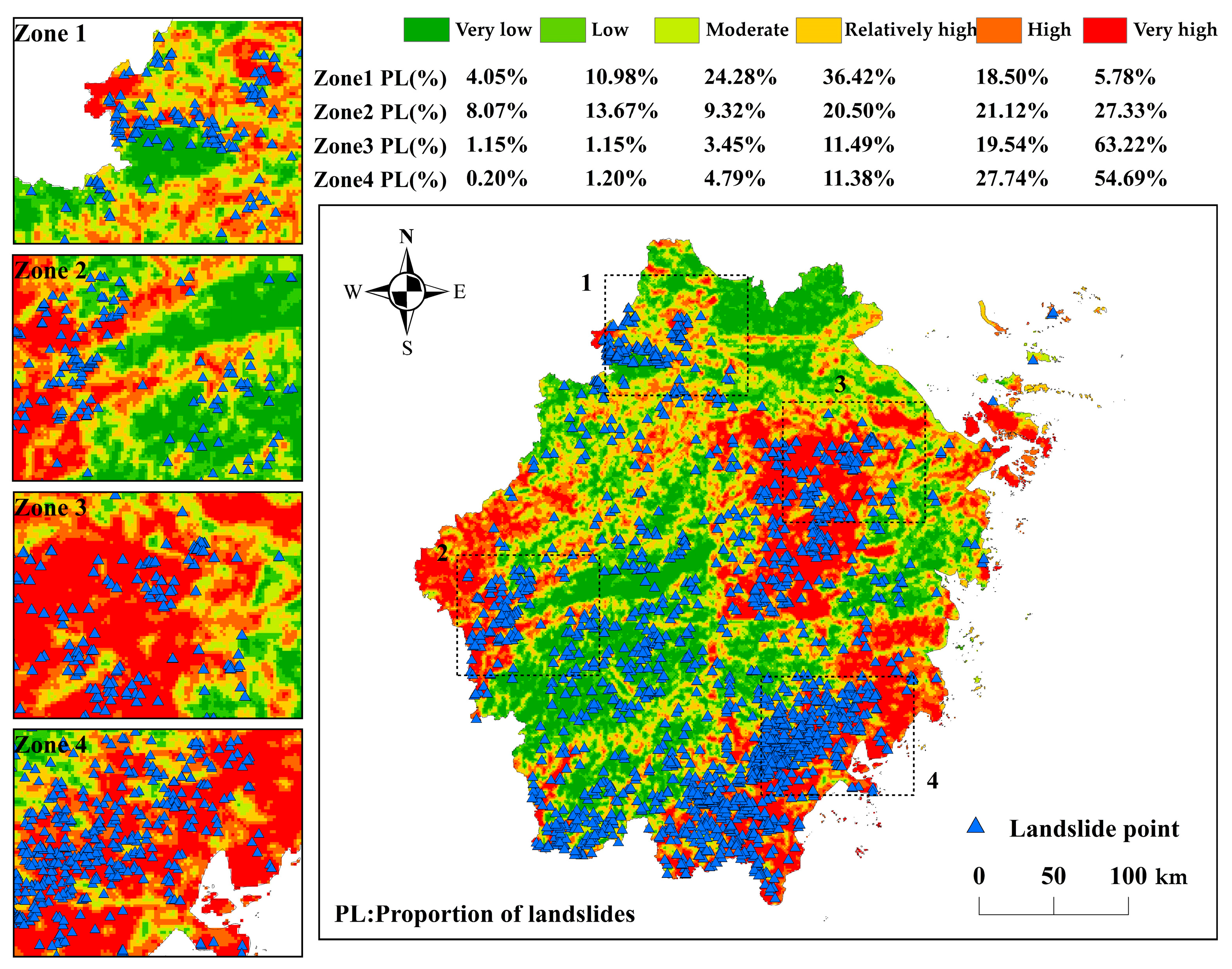
| Data | Time | Resolution | Source |
|---|---|---|---|
| Precipitation | 1961–2024 | Text data | China Meteorological Administration (CMA) |
| River | – | Line data | Chinese Academy of Sciences, Resource and Environment Science Data Center |
| Landslide location | 1974–2015 | Point data | China Water Resources Authority (CWRA) |
| Road | - | Line data | Chinese Academy of Sciences, Resource and Environment Science Data Center |
| NDVI | 2000–2022 | 1000 m | National Tibetan Plateau Data Center |
| Elevation | - | 30 m | Shuttle Radar Topography Mission (NASA SRTM) |
| Soil texture | - | 1000 m | Harmonized World Soil Database (HWSD) |
| Fault | - | Line data | Geoscientific Data & Discovery Publishing System |
| Conditioning Factor | Class | Classification Standard |
|---|---|---|
| DEM/(m) | 6 | <100; 100–200; 200–400; 400–600; 600–800; >800 |
| Slope/(°) | 6 | <2°; 2–5°; 5–10°; 10–15°; 15–20°; >20° |
| Slope aspect | 9 | North; northeast; east; southeast; south; southwest; west; northwest; flat |
| Topographic Wetness Index (TWI) | 6 | <6; 6–8; 8–10; 10–12; 12–15; >15 |
| Distance to fault(m) | 6 | <500; 500–1000; 1000–3000; 3000–5000; 5000–10,000; >10,000 |
| NDVI | 5 | <0.2; 0.2–0.4; 0.4–0.6; 0.6–0.8; >0.8 |
| Distance to river(m) | 6 | <500; 500–1000; 1000–3000; 3000–5000; 5000–8000; >8000 |
| Effective antecedent precipitation/ (mm) | 6 | < 25; 25–50; 50–100; 100–200; 200–300; >300 |
| Soil texture | 3 | Coarse textured; medium textured; fine textured |
| Distance to road/(m) | 6 | <100; 100–300; 300–500; 500–1000; 1000–3000; >3000 |
| Terrain Ruggedness Index (TRI) | 6 | 0–73; 73–176; 176–275; 275–382; 382–516; >516 |
| Sediment Transport Index (STI) | 6 | <1.77; 1.77–7.97; 7.97–22.15; 22.15–44.75; 44.75–77.09; >77.09 |
| Stream power index | 6 | <−10; −10–−7; −7–−3; −3–−1; −1–1; >1 |
| Lithology | 13 | Acid plutonics; acid volcanic; basic plutonics; basic volcanics; carbonate sedimentary rock; intermediate plutonics; intermediate volcanics; metamorphics; mixed sedimentary rock; pyroclastics; siliciclastic sedimentary; unconsolidated sediment; undefined |
| Precipitation Coefficient | 0.1 | 0.2 | 0.3 | 0.4 | 0.5 | 0.6 | 0.7 | 0.8 | 0.9 | 1 |
|---|---|---|---|---|---|---|---|---|---|---|
| Pearson correlation | 0.3093 | 0.3130 | 0.3168 | 0.3207 | 0.3247 | 0.3288 | 0.3325 | 0.3352 | 0.3348 | 0.3278 |
| Model | Accuracy | Recall | F1 Score | Log Loss | Optimized Hyperparameters |
|---|---|---|---|---|---|
| RF | 89.02% | 89.66% | 0.8909 | 0.2844 | n_estimators = 500; max_depth = 20; min_samples_split = 2; min_samples_leaf = 1; max_features = ‘sqrt’ |
| XGB | 89.02% | 89.82% | 0.8910 | 0.2417 | n_estimators = 200; max_depth = 3; learning_rate = 0.2; subsample = 0.9; colsample_bytree = 0.8 |
| MLP | 81.60% | 83.20% | 0.8188 | 0.3836 | hidden_layer_sizes = (64, 32); activation = ‘relu’; solver = ‘adam’; alpha = 0.01; learning_rate_init = 0.001; max_iter = 1000; batch_size = ‘auto’; early_stopping = True |
| KNN | 84.26% | 83.04% | 0.8406 | 0.4056 | n_neighbors = 10; weights = ‘distance’; metric = ‘manhattan’ |
| GBM | 89.35% | 90.15% | 0.8942 | 0.2548 | n_estimators = 500; max_depth = 3; learning_rate = 0.1; min_samples_split = 2; subsample = 0.9 |
| SVM | 86.28% | 86.75% | 0.8633 | 0.3130 | kernel = ‘rbf’; C = 10; gamma = ‘scale’ |
Disclaimer/Publisher’s Note: The statements, opinions and data contained in all publications are solely those of the individual author(s) and contributor(s) and not of MDPI and/or the editor(s). MDPI and/or the editor(s) disclaim responsibility for any injury to people or property resulting from any ideas, methods, instructions or products referred to in the content. |
© 2025 by the authors. Licensee MDPI, Basel, Switzerland. This article is an open access article distributed under the terms and conditions of the Creative Commons Attribution (CC BY) license (https://creativecommons.org/licenses/by/4.0/).
Share and Cite
Cheng, C.; Li, Y.; Zhu, D.; Liu, Y.; Wu, Y.; Lin, D.; Guo, H. Rain-Induced Shallow Landslide Susceptibility Under Multiple Scenarios Based on Effective Antecedent Precipitation. Appl. Sci. 2025, 15, 6241. https://doi.org/10.3390/app15116241
Cheng C, Li Y, Zhu D, Liu Y, Wu Y, Lin D, Guo H. Rain-Induced Shallow Landslide Susceptibility Under Multiple Scenarios Based on Effective Antecedent Precipitation. Applied Sciences. 2025; 15(11):6241. https://doi.org/10.3390/app15116241
Chicago/Turabian StyleCheng, Chuanmei, Ying Li, Dong Zhu, Yu Liu, Yongqiu Wu, Degen Lin, and Hao Guo. 2025. "Rain-Induced Shallow Landslide Susceptibility Under Multiple Scenarios Based on Effective Antecedent Precipitation" Applied Sciences 15, no. 11: 6241. https://doi.org/10.3390/app15116241
APA StyleCheng, C., Li, Y., Zhu, D., Liu, Y., Wu, Y., Lin, D., & Guo, H. (2025). Rain-Induced Shallow Landslide Susceptibility Under Multiple Scenarios Based on Effective Antecedent Precipitation. Applied Sciences, 15(11), 6241. https://doi.org/10.3390/app15116241






